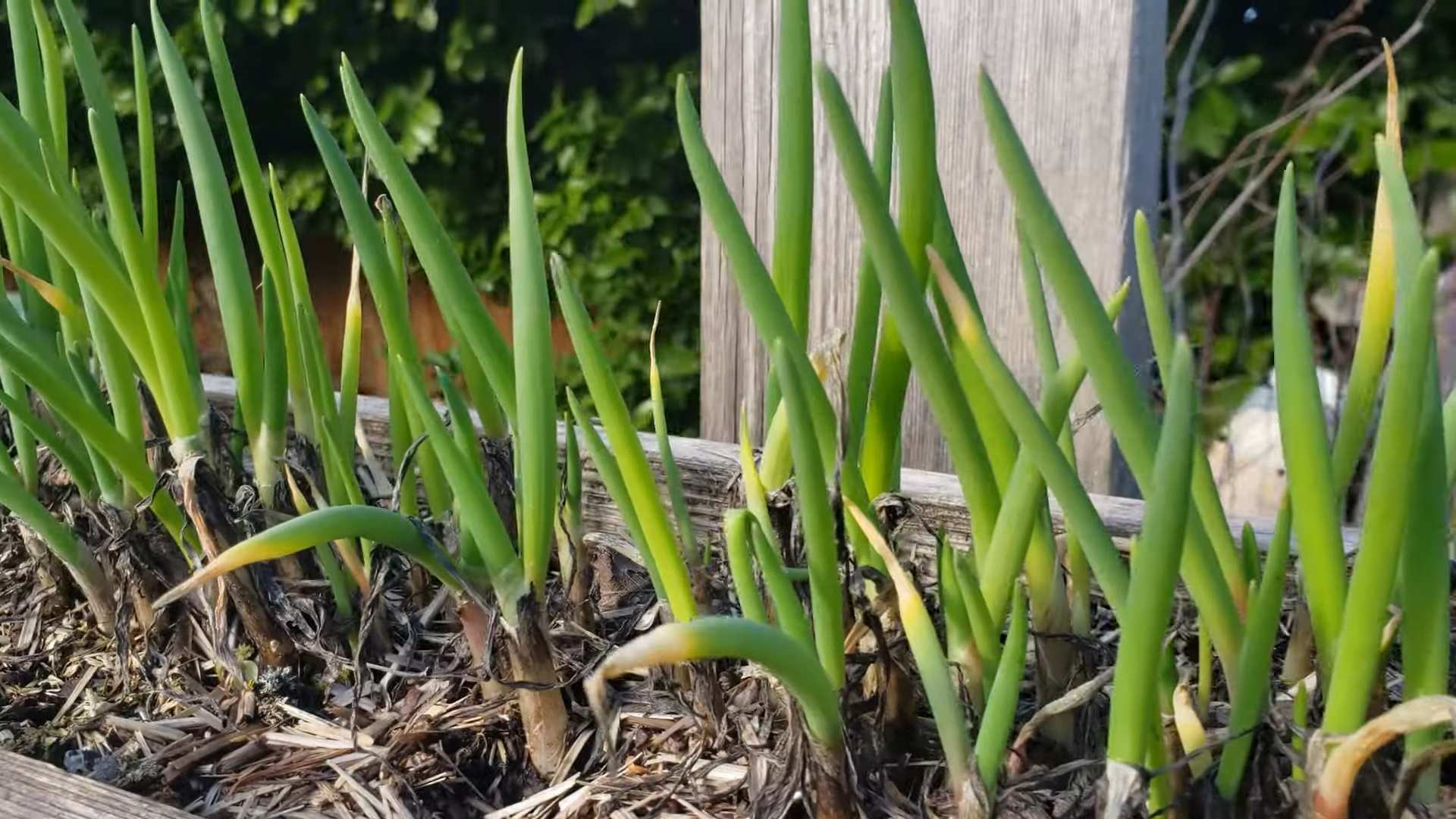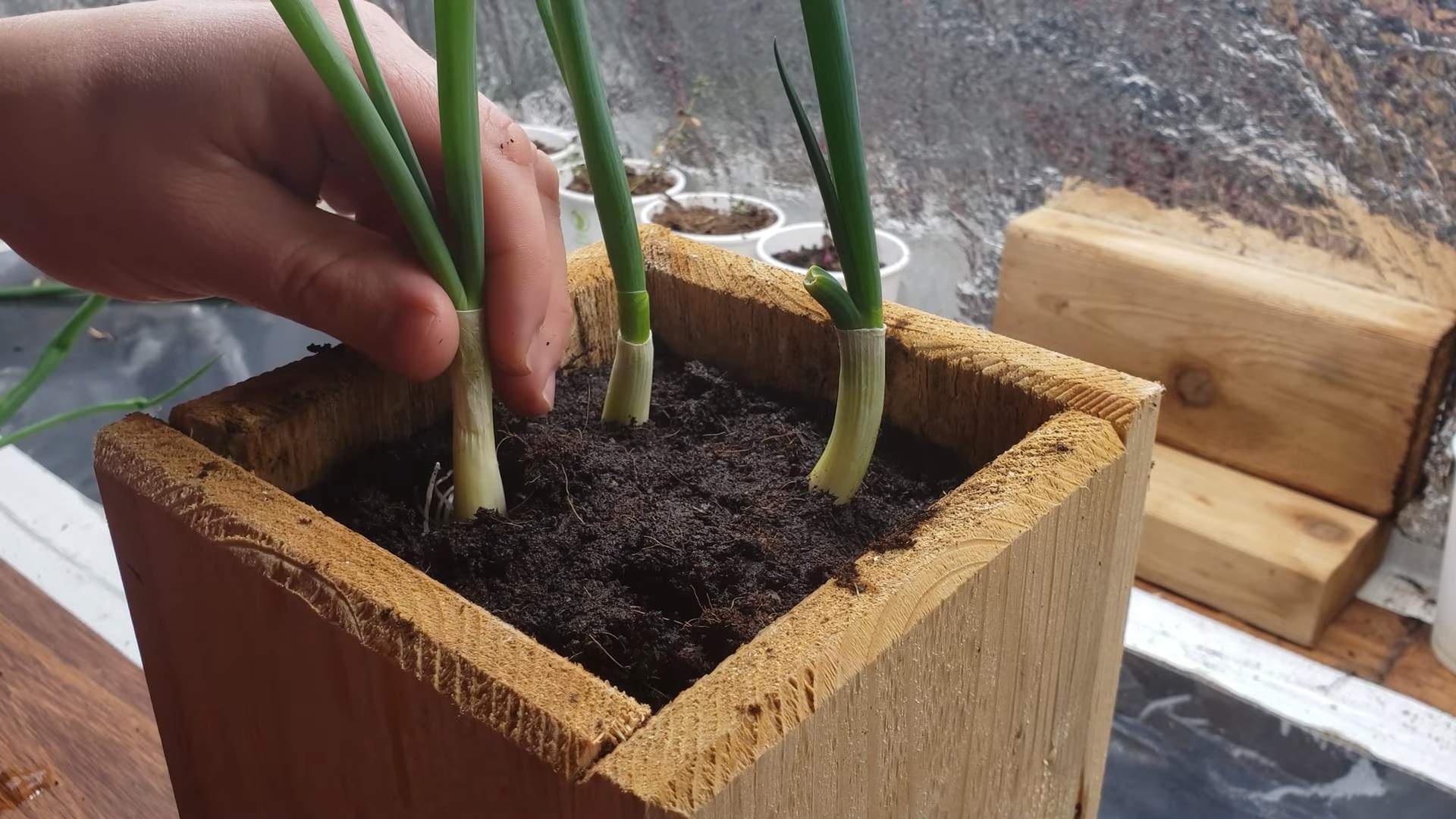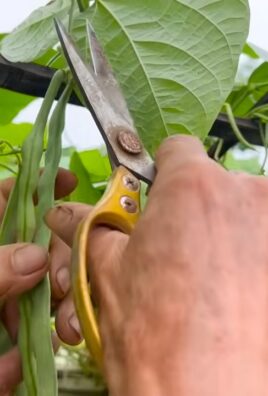Regrow Green Onions from Scraps: Unlock the secret to endless fresh flavor right from your kitchen! Have you ever tossed those little green onion ends, thinking they were destined for the trash? Well, prepare to be amazed! This simple DIY trick will not only save you money but also bring the joy of gardening into your home, no matter how small your space.
The practice of propagating plants from scraps isn’t new. For generations, resourceful gardeners have found ways to extend their harvest and minimize waste. It’s a testament to our connection with nature and a sustainable approach to living. Think of it as a modern take on age-old wisdom!
Why should you learn to regrow green onions from scraps? Because it’s incredibly easy, rewarding, and practical! Imagine never having to run to the store just for a few green onions to garnish your favorite dish. Plus, it’s a fantastic way to introduce kids to the magic of gardening and teach them about plant life cycles. I’m excited to share this simple yet effective method that will keep your kitchen stocked with fresh green onions, ready to add a burst of flavor to any meal. Let’s get started!

Regrowing Green Onions: A Simple DIY Guide
Hey there, fellow green thumb enthusiasts! Ever find yourself tossing those green onion roots after chopping off the tasty green parts? Well, stop right there! I’m going to show you how to easily regrow green onions from those seemingly useless scraps, saving you money and ensuring a constant supply of fresh flavor. It’s a super simple DIY project that even beginners can master. Let’s get started!
What You’ll Need
Before we dive in, let’s gather our supplies. This is a pretty low-key project, so you probably already have most of these things lying around:
* Green onion scraps (the white root ends, about 1-2 inches long)
* A glass or jar
* Water
* Potting soil (optional, for long-term growth)
* A small pot or container (optional, for long-term growth)
* A sunny windowsill or grow light
Regrowing Green Onions in Water: Step-by-Step
This is the easiest and quickest way to get your green onions growing again. It’s perfect for a fast turnaround and a continuous supply of fresh greens.
1. Prepare the Scraps: After using your green onions, don’t throw away the white root ends! Make sure you have about 1-2 inches of the white part, including the roots. If the roots are excessively long, you can trim them slightly, but be careful not to cut them off completely.
2. Find a Suitable Container: Grab a glass, jar, or even a small bowl. The container should be tall enough to hold the green onion scraps upright and deep enough to hold water without tipping over easily. I personally like using mason jars because they’re sturdy and look cute on my windowsill.
3. Add Water: Fill the container with enough water to cover the roots, but don’t submerge the entire white part of the green onion. You want the very top of the white part to be exposed to air. This prevents rotting.
4. Place the Scraps in Water: Carefully place the green onion scraps in the water, root-side down. Make sure they are standing upright. You can arrange several scraps in the same container, but don’t overcrowd them.
5. Find a Sunny Spot: Place the container on a sunny windowsill or under a grow light. Green onions need sunlight to grow, so aim for at least 6 hours of sunlight per day. If you don’t have a sunny windowsill, a grow light will work just as well.
6. Change the Water Regularly: This is crucial! Change the water every 1-2 days to prevent bacteria growth and keep the water fresh. This will also provide the green onions with the oxygen they need to thrive.
7. Watch Them Grow!: Within a few days, you should start to see new green shoots emerging from the top of the green onion scraps. It’s so rewarding to watch them grow!
8. Harvest Your Green Onions: Once the green shoots are a few inches long, you can start harvesting them. Simply snip off the amount you need with scissors. The green onions will continue to grow, providing you with a continuous supply of fresh greens.
Transplanting to Soil for Long-Term Growth (Optional)
While regrowing green onions in water is a great way to get a quick harvest, transplanting them to soil will allow them to grow larger and potentially even produce flowers and seeds. This is a good option if you want a more permanent green onion plant.
1. Choose a Pot: Select a small pot or container with drainage holes. The pot should be large enough to accommodate the roots of the green onions. A 4-6 inch pot is usually sufficient.
2. Prepare the Potting Soil: Fill the pot with good-quality potting soil. You can also add some compost to the soil to provide extra nutrients.
3. Carefully Remove the Green Onions from Water: Gently remove the green onion scraps from the water. Be careful not to damage the roots.
4. Plant the Green Onions: Make a small hole in the soil for each green onion scrap. Plant the scraps so that the white part is buried in the soil and the green shoots are exposed.
5. Water Thoroughly: Water the soil thoroughly after planting. Make sure the water drains out of the drainage holes.
6. Place in a Sunny Location: Place the pot in a sunny location or under a grow light. Green onions need at least 6 hours of sunlight per day.
7. Water Regularly: Water the soil regularly, keeping it moist but not soggy. Allow the top inch of soil to dry out between waterings.
8. Fertilize (Optional): You can fertilize your green onions every few weeks with a balanced liquid fertilizer. This will help them grow stronger and produce more greens.
9. Harvest and Enjoy!: As with the water method, you can harvest the green onions by snipping off the green shoots as needed. They will continue to grow and produce more greens.
Tips for Success
Here are a few extra tips to help you get the most out of your green onion regrowing project:
* Use Fresh Scraps: The fresher the green onion scraps, the better the chances of them regrowing. Try to use scraps that are only a day or two old.
* Don’t Overcrowd: Avoid overcrowding the container with too many green onion scraps. This can restrict their growth and lead to rotting.
* Provide Adequate Sunlight: Green onions need plenty of sunlight to grow. If you don’t have a sunny windowsill, use a grow light.
* Keep the Water Clean: Changing the water regularly is essential for preventing bacteria growth and keeping the green onions healthy.
* Be Patient: It may take a few days for the green onions to start growing. Don’t give up if you don’t see results immediately.
* Experiment: Try different containers, soil types, and fertilizers to see what works best for you.
* Consider the Variety: Some green onion varieties might regrow more vigorously than others. Experiment to see which ones you prefer.
* Watch for Pests: Keep an eye out for pests like aphids or spider mites. If you see any, treat them with an appropriate insecticide or organic pest control method.
* Rotate Your Crops: If you’re growing green onions in soil, rotate them with other crops to prevent soil depletion.
* Enjoy the Process!: Regrowing green onions is a fun and rewarding project. Enjoy the process of watching them grow and harvesting your own fresh greens.
Troubleshooting
Sometimes, things don’t go exactly as planned. Here are a few common problems you might encounter and how to fix them:
* Rotting: If the green onion scraps start to rot, it’s usually due to overwatering or poor water quality. Make sure you’re not submerging the entire white part of the green onion in water, and change the water more frequently.
* Slow Growth: If the green onions are growing slowly, it could be due to lack of sunlight or nutrients. Make sure they’re getting enough sunlight, and consider fertilizing them if you’re growing them in soil.
* Yellowing Leaves: Yellowing leaves can be a sign of overwatering or underwatering. Adjust your watering schedule accordingly. It could also indicate a nutrient deficiency, so consider fertilizing.
* Pests: If you see pests on your green onions, treat them with an appropriate insecticide or organic pest control method.
Beyond the Basics: Expanding Your Green Onion Garden
Once you’ve mastered the basics of regrowing green onions from scraps, you can start experimenting with other techniques and expanding your green onion garden. Here are a few ideas:
* Growing from Seed: You can also grow green onions from seed. This will give you more control over the variety of green onions you grow.
* Succession Planting: Plant new green onion scraps every few weeks to ensure a continuous supply of fresh greens.
* Companion Planting: Plant green onions alongside other vegetables to deter pests and improve growth. Good companion plants for green onions include carrots, tomatoes, and lettuce.
* Saving Seeds: If you allow your green onions to flower, you can collect the seeds and use them to grow new plants.
* Different Varieties: Explore different varieties of green onions, such as scallions, bunching onions, and Japanese bunching onions. Each variety has its own unique flavor and characteristics.
I hope this guide has inspired you to start regrowing your own green onions. It’s a simple, sustainable, and rewarding way to add fresh flavor to your meals. Happy gardening!

Conclusion
So, there you have it! Regrowing green onions from scraps isn’t just a fun kitchen experiment; it’s a practical, sustainable, and incredibly rewarding way to ensure you always have fresh green onions on hand. Think about it: no more last-minute trips to the grocery store when you realize you’re missing that crucial ingredient for your stir-fry, salsa, or garnish. This simple DIY trick transforms kitchen waste into a continuous supply of flavorful goodness.
But the benefits extend beyond mere convenience. By regrowing your green onions, you’re actively reducing food waste, contributing to a more eco-friendly lifestyle, and saving money in the process. It’s a win-win-win situation! Plus, it’s a fantastic way to introduce children to the wonders of gardening and the magic of watching something grow.
Why is this a must-try? Because it’s easy, effective, and environmentally conscious. It requires minimal effort, space, and resources, yet yields a surprisingly abundant harvest. You don’t need a green thumb or fancy equipment – just a glass of water, a sunny spot, and a little patience.
Ready to take it to the next level? Consider these variations:
* Hydroponic Haven: Once your green onions have established strong roots in water, you can transfer them to a small hydroponic system for even faster growth and nutrient delivery.
* Container Gardening Companion: Plant your regrown green onions in a pot alongside other herbs like basil, parsley, or chives for a miniature herb garden.
* Soil Enrichment: If you prefer a more traditional approach, plant your green onion scraps directly into nutrient-rich soil. Amend the soil with compost or worm castings for optimal growth.
* Different Varieties: Experiment with regrowing different varieties of green onions, such as scallions or bunching onions, to discover your favorite flavor profiles.
The possibilities are endless! The key is to start small, observe your plants, and adjust your approach as needed. Don’t be afraid to experiment and have fun with it.
We wholeheartedly encourage you to try this simple yet impactful DIY trick. Regrowing green onions from scraps is a game-changer for any home cook or gardening enthusiast. It’s a small step towards a more sustainable and self-sufficient lifestyle.
Now, it’s your turn! Give it a try, and don’t forget to share your experiences with us. We’d love to see your regrown green onions thriving in your kitchens and gardens. Post pictures, share tips, and let us know what works best for you. Together, we can create a community of resourceful and eco-conscious cooks. Happy growing!
Frequently Asked Questions (FAQ)
How long does it take for green onions to regrow?
Generally, you’ll start to see noticeable regrowth within a few days. Within a week, you should have a significant amount of new green growth. The speed of regrowth depends on factors like sunlight, water quality, and temperature. Warmer temperatures and ample sunlight will encourage faster growth. Expect to harvest usable green onions within 1-2 weeks.
What part of the green onion do I need to regrow it?
You need the white bulb end with the roots attached (or the potential for roots). Cut off the green tops, leaving about 1-2 inches of the white base intact. This base contains the dormant buds that will sprout new green shoots. Make sure the roots are clean and free of any debris.
Do I need to change the water regularly?
Yes, changing the water every 1-2 days is crucial. This prevents the water from becoming stagnant and harboring bacteria or mold, which can hinder growth and potentially harm the green onions. Fresh water provides oxygen and nutrients, promoting healthy root development and vibrant green growth.
How much sunlight do regrowing green onions need?
Green onions thrive in bright, indirect sunlight. Place your glass or container near a sunny window, preferably one that faces south or east. Avoid direct sunlight, especially during the hottest part of the day, as it can scorch the delicate leaves. If you don’t have access to a sunny window, you can supplement with a grow light.
Can I regrow green onions in soil instead of water?
Absolutely! While water propagation is a great starting point, you can eventually transplant your regrown green onions into soil. Once the roots are well-established (about 1-2 inches long), gently transfer the green onion to a pot filled with well-draining potting mix. Keep the soil consistently moist, but not waterlogged.
How many times can I regrow green onions from the same base?
You can typically regrow green onions from the same base several times, usually 2-3 times, before the base starts to lose its vitality. After each harvest, leave about an inch of green growth to allow the plant to regenerate. Eventually, the base will become exhausted, and you’ll need to start with a fresh green onion.
What if my green onions start to turn yellow or brown?
Yellowing or browning leaves can indicate a few potential problems. It could be due to insufficient sunlight, poor water quality, or nutrient deficiencies. Ensure your green onions are receiving adequate sunlight and that you’re changing the water regularly. If the problem persists, consider adding a diluted liquid fertilizer to the water or transplanting the green onion to soil.
Can I eat the regrown green onions?
Yes, absolutely! The regrown green onions are perfectly safe and delicious to eat. They will have the same flavor and texture as store-bought green onions. Simply harvest them as needed by snipping off the green tops with scissors.
Are there any pests or diseases that affect regrowing green onions?
Regrowing green onions are generally pest and disease-resistant, especially when grown indoors. However, occasionally, they may be susceptible to aphids or fungal infections. If you notice any pests, try washing them off with a strong stream of water or using an insecticidal soap. To prevent fungal infections, ensure good air circulation and avoid overwatering.
What are the benefits of regrowing green onions?
The benefits are numerous! You’ll save money by reducing your grocery bill, reduce food waste by utilizing scraps, have a constant supply of fresh green onions, and enjoy the satisfaction of growing your own food. It’s also an environmentally friendly practice that promotes sustainability. Plus, it’s a fun and educational activity for kids and adults alike. The ease of this DIY trick makes it a must-try for anyone looking to add a touch of green to their kitchen and their lifestyle.




Leave a Comment